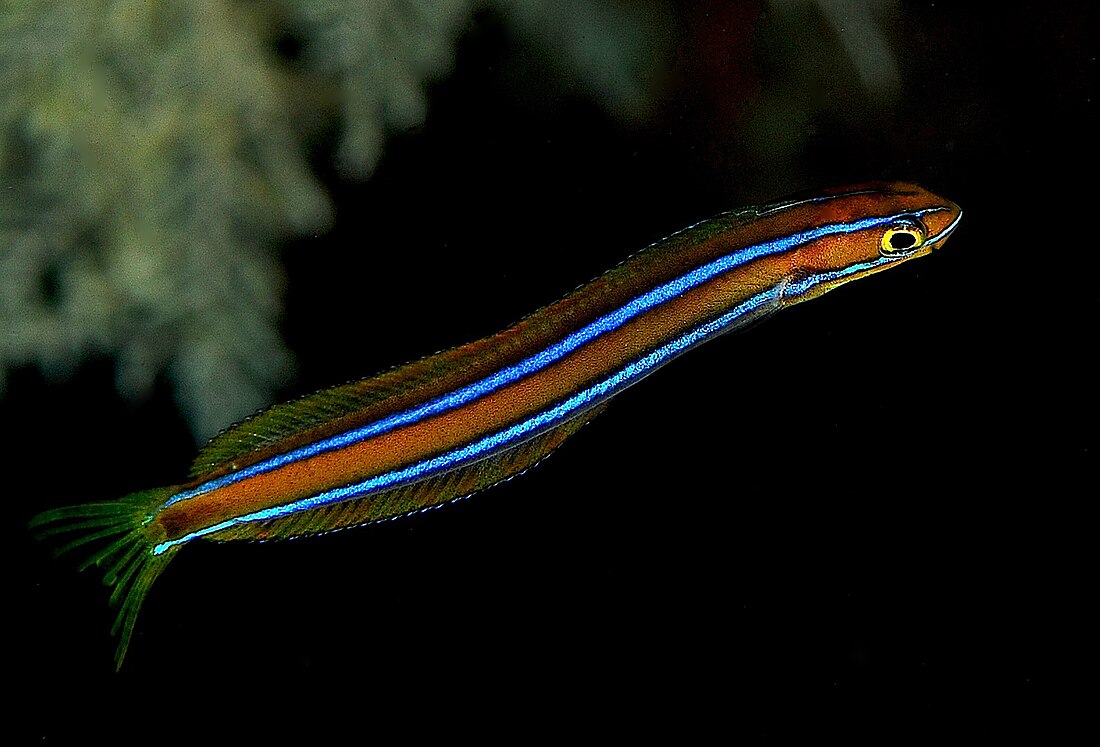Top Qs
Timeline
Chat
Perspective
Bluestriped fangblenny
Species of fish From Wikipedia, the free encyclopedia
Remove ads
Plagiotremus rhinorhynchos, commonly called the bluestriped fangblenny, is a species of combtooth blenny found in coral reefs in the Pacific and Indian Ocean. This species reaches a length of 12 centimetres (4.7 in) SL.[2] It is also known as the bluestriped blenny, bluestriped sabretooth blenny, blunt-nose blenny, cleaner mimic, tube-worm blenny or the two-stripe blenny. They hide in deserted worm tubes or other small holes.

The fangblenny is a specialised mimic of juvenile bluestreak cleaner wrasse. Those fish serve as cleaners to larger host fish, which attend to have ectoparasites removed. The fangblenny does no cleaning, but bites the host fish and leaves. Its opioid-containing venom helps it escape, as it gives a pain-free bite which also dulls the host's reactions.
Remove ads
Description
From before birth, their eggs are demersal and adhesive and attach to substrates via a filamentous adhesive pad or pedestal. The bluestriped fangblenny can attain around 90mm in length. Two distinct colour phases of this fish are present; blue with a black stripe from snout to tail, or orange with two narrow blue lines from snout to tail. Unlike most blennies, the bluestriped fangblenny is free swimming. Adults inhabit clear, coral-rich areas of lagoon and seaward reefs and it is fairly common on both coral and rocky reefs, usually occurring singly or in pairs. [citation needed] They are known for being aggressive and feed on skin, mucus and sometimes other fish scales. They bite divers when alarmed.
Remove ads
Aggressive mimicry
Bluestriped fangblenny mimic the juvenile bluestreak cleaner wrasse, Labroides dimidiatus, to enable them to loiter at cleaner stations and dupe clients waiting to be cleaned.[3] Their success in this aggressive mimicry is, like Batesian mimicry, frequency-dependent: it works best when the mimic is rare compared to the genuinely symbiotic cleaner fish.[4]
The fangblenny has an unusual adaptation for biting and escaping without being pursued: its bite is pain-free, as it has a venom containing morphine-like opioids, which dulls pain and reduces blood pressure. The fall in the host's blood pressure makes it lose co-ordination, just as a human feels dizzy when blood pressure is low, giving the fangblenny time to escape. This may explain why other coral reef fish mimic the fangblenny.[5]
Remove ads
See also
References
External links
Wikiwand - on
Seamless Wikipedia browsing. On steroids.
Remove ads


